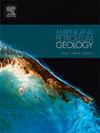探索巴基斯坦东特提斯地区古环境振荡和泰西期碳酸盐岩年代地层学的多代理方法
IF 3.7
2区 地球科学
Q1 GEOSCIENCES, MULTIDISCIPLINARY
引用次数: 0
摘要
这项研究首次将地球化学分析与传统的微古生物学和沉积学方法结合起来,重新界定了古新世晚期洛克哈特石灰岩的年代层位、古环境历史和区域相关性,其四个不同的剖面覆盖了整个上印度河盆地。根据年龄诊断有孔虫物种,我们报告洛克哈特石灰岩为 SBZ3 至 SBZ4(萨尼特纪),而之前的研究将其限制为 SBZ3。对八个不同微地层的解释揭示了一个逐渐变浅的上升序列,表明了一个动态的沉积环境,其能量水平和水深从内斜、中斜到外斜不等。从矿物学角度看,地层主要由方解石组成,石英是次要成分。地球化学分析,特别是主要氧化物分析结果表明,氧化钙是主要成分,同时还含有大量的二氧化硅、氧化铁、氧化铝和氧化镁。SiO2 和 Al2O3 的比例较低,与 CaO 呈负相关,而 Mg/Ca 的比例较高,这表明在石灰岩沉淀过程中硅质碎屑的输入量有限,从而支持了从岩相分析中推断出的浅海沉积环境。痕量元素比率表明主要是缺氧条件,这也与浅海环境中氧气充足的水域相吻合。古盐度和古温度指标表明,石灰岩岩层具有正常的海洋条件和中等的古温度条件,页岩岩层具有泻湖条件,这与推测的浅海环境一致。总有机碳(TOC)含量较低,表明存在来自循环或大陆来源的第三类和第四类有机质,表明沉积环境中有机质保存有限。粘土矿物学表明,这里主要是潮湿的环境,偶尔也有温暖的气候以及潮湿与干旱交替的时期。洛克哈特石灰岩海相的沉积标志着东特提斯的横断,在此之前,受古特提斯构造作用下不断演化的古气候和地貌的影响,汉沽地层的大陆相沉积发生了倒退。本文章由计算机程序翻译,如有差异,请以英文原文为准。
A multi-proxy approach to explore paleoenvironmental oscillations and chronostratigraphy of Thanetian carbonates in Eastern Tethys, Pakistan
This study is the first to incorporate geochemical analyses alongside traditional micropaleontological and sedimentological methods to redefine the chronostratigraphy, paleoenvironmental history and regional correlation of the Late Paleocene Lockhart Limestone from four distinct sections covering the entire Upper Indus Basin. Based on the age diagnostic foraminiferal species, we report SBZ3 to SBZ4 (Thanetian age) for the Lockhart Limestone in contrast to previous studies restricting it to SBZ3. The interpretation of eight distinct microfacies reveals a progressively shallowing upward sequence, indicating a dynamic depositional environment with varying energy levels and water depths ranging from inner, middle, to outer ramp settings. Mineralogically, the formation is predominantly composed of calcite, with quartz being the next significant component. Geochemical analyses, specifically the major oxide results, highlight that CaO is the primary constituent, while notable amounts of SiO2, Fe2O3, Al2O3, and MgO are present. The low proportions of SiO2 and Al2O3, combined with their negative correlation with CaO, and high Mg/Ca ratio suggest limited siliciclastic input during the precipitation of limestone that supports the shallow marine depositional environment inferred from the facies analysis. Trace elemental ratios, indicating predominantly oxic conditions, also align with the well-oxygenated waters of a shallow marine setting. Paleosalinity and paleotemperature indicators suggest normal marine and moderate paleotemperature conditions for limestone facies, with lagoonal conditions for shale facies, which is consistent with the interpreted shallow marine environment. The low Total Organic Carbon (TOC) content indicates the presence of type-III and IV organic matter, derived from recycling or continental sources, suggesting limited organic matter preservation in the depositional setting. The clay mineralogy suggests mainly humid conditions with occasional warm climates and alternating humid and arid periods. The deposition of the marine facies of Lockhart Limestone marks the transgression of the Eastern Tethys following a regressive episode that deposited the continental facies of the Hangu Formation, influenced by evolving paleoclimate and geomorphology under Paleo-Tethys tectonism.
求助全文
通过发布文献求助,成功后即可免费获取论文全文。
去求助
来源期刊

Marine and Petroleum Geology
地学-地球科学综合
CiteScore
8.80
自引率
14.30%
发文量
475
审稿时长
63 days
期刊介绍:
Marine and Petroleum Geology is the pre-eminent international forum for the exchange of multidisciplinary concepts, interpretations and techniques for all concerned with marine and petroleum geology in industry, government and academia. Rapid bimonthly publication allows early communications of papers or short communications to the geoscience community.
Marine and Petroleum Geology is essential reading for geologists, geophysicists and explorationists in industry, government and academia working in the following areas: marine geology; basin analysis and evaluation; organic geochemistry; reserve/resource estimation; seismic stratigraphy; thermal models of basic evolution; sedimentary geology; continental margins; geophysical interpretation; structural geology/tectonics; formation evaluation techniques; well logging.
 求助内容:
求助内容: 应助结果提醒方式:
应助结果提醒方式:


